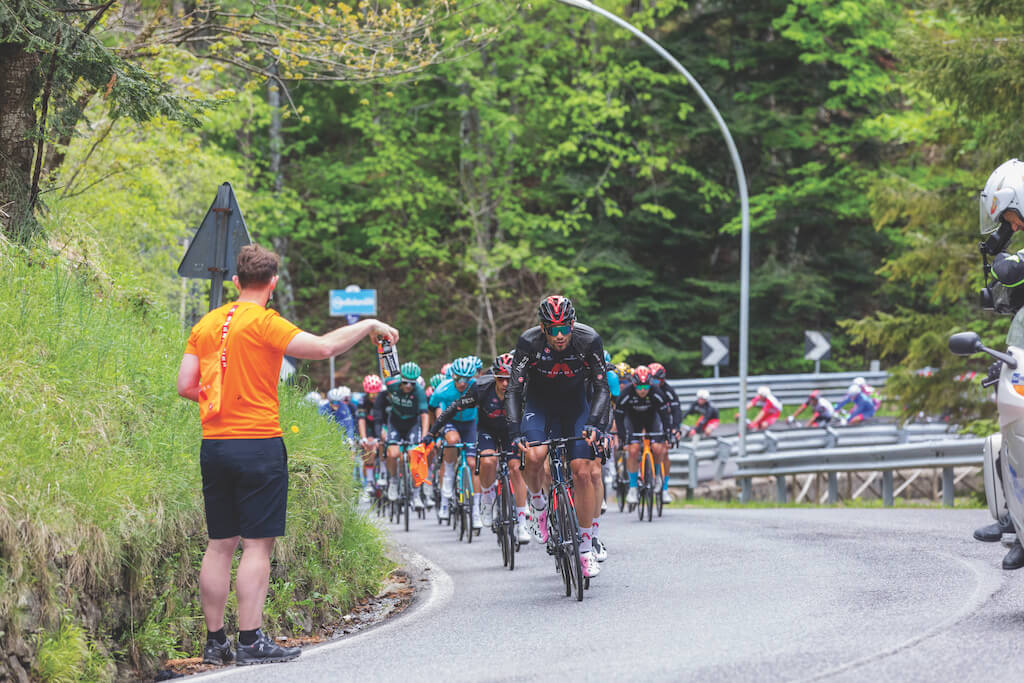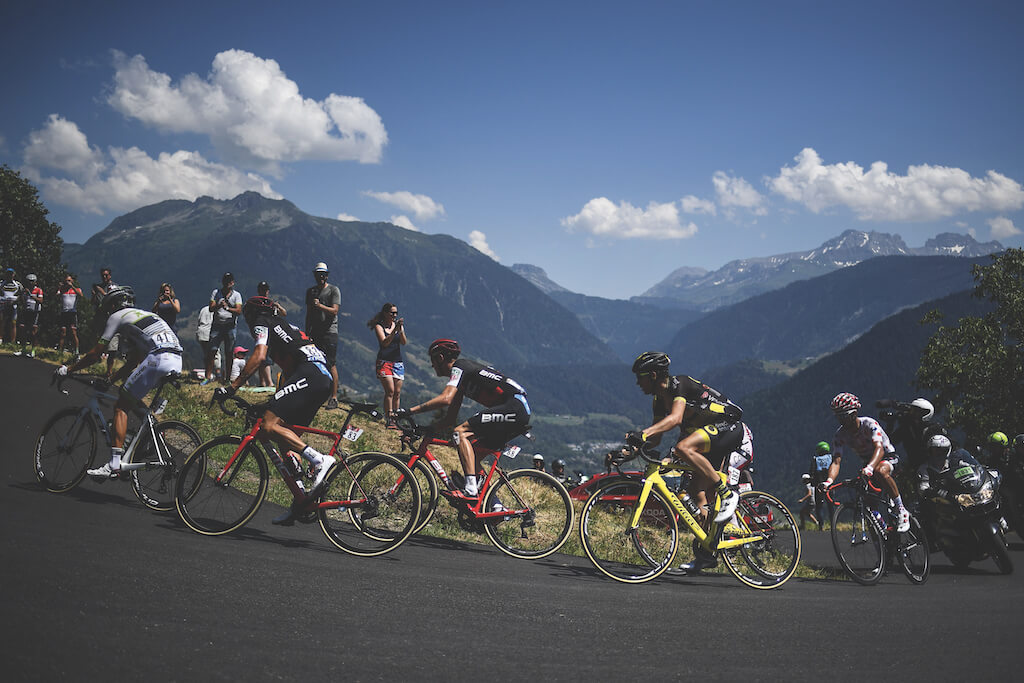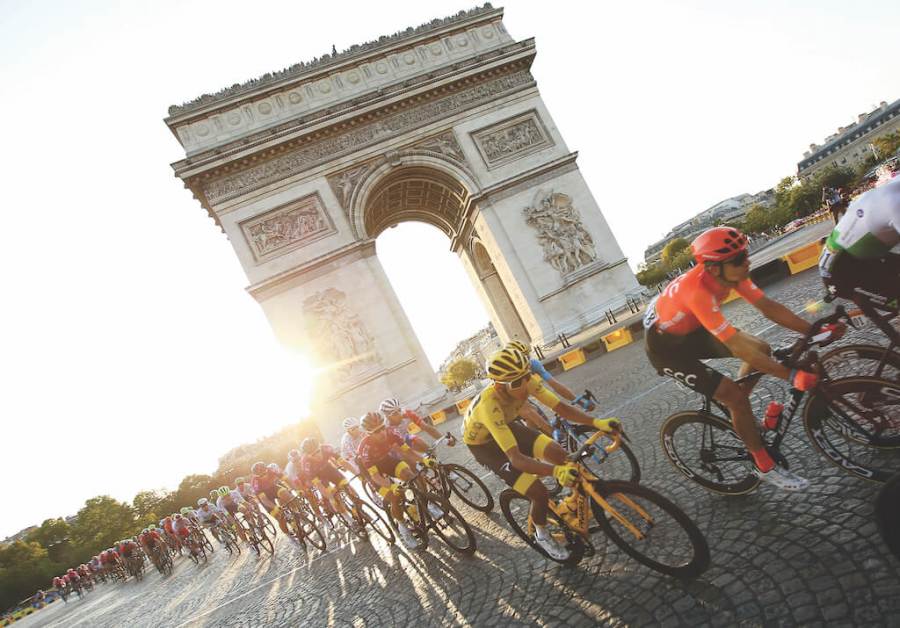The Tour de France is one of the world’s toughest, and certainly most iconic, endurance events, with over 180 elite riders covering 3,383km and tackling 30,000m of vertical ascent.
During the three-week race, which is divided into 21 stages across June and July, each rider will burn more than 140,000 calories.
This summer, Britain’s 2018 Tour winner Geraint Thomas is hunting his second victory with INEOS Grenadiers (formerly Team Sky), the all-conquering British team that has won seven of the last nine Tours.
But in order to get race-ready, the squad has endured months of hard training, backed up by smart nutritional plans and intelligent sports science.
Here INEOS Grenadiers’ coach Conor Taylor and nutritionist Javier Gonzalez reveal how the riders arrive at the start line in peak condition.

Team INEOS on a training ride before the Tour starts on 26 June
The importance of low-intensity exercise
To build an elite endurance engine, pro riders prioritise low- to moderate-intensity training.
“Around 75-85 per cent of our riders’ total training time is spent doing long, continuous, low- to moderate-intensity cycling,” explains Taylor.
“Only 20 per cent of their training is of a high-intensity nature. Those low-intensity rides are typically at 65-70 per cent of their maximal heart rate and can last four to seven hours.”
This high-volume, low-intensity approach triggers adaptations within the riders’ cardiovascular, metabolic and neuromuscular systems, which help them better endure longer rides.
“One of the primary adaptations is that our riders become more efficient,” explains Taylor. “At that intensity and volume, you’re predominantly using fat, instead of carbohydrate, as a fuel source.
“We’ve all got ample fat stores in the body, so we are just trying to train the body to utilise that fat, because carbohydrate can only be stored in relatively small quantities.
“A cyclist with high efficiency will always use less oxygen than a cyclist with poor efficiency, when they both cycle at the same given power output or speed.”
Stick to real food
To fuel up for this huge volume of training, the riders take a ‘food-first’ approach, relying mainly on nutritious ‘real’ food, with supplements used sparingly. Breakfast is usually a protein-rich omelette with a portion of energy-dense rice.
“The amount of carbohydrate in something like porridge is relatively low compared to rice,” explains Gonzalez.
During rides, the cyclists fuel up with homemade rice cakes flavoured with cream cheese or cinnamon.
“They are not the kind of crispy rice cakes you buy in shops, they are more like a solidified risotto,” explains Gonzalez. “Rice is very easy to digest and easy on the stomach.”
A post-ride lunch is typically tuna steak with quinoa and tomato salad. And dinner might be salmon and rice with an Asian broccoli salad.
“During training periods the riders eat more veg, too, as the nutrients support health and immunity,” adds Gonzalez.
Varied training forces positive adaptations
Riders begin their winter training in October and steadily accumulate volume as the weeks go by.
“It is very individual, but as a guide if you increase your weekly volume by ten per cent that is a good starting point to safely progress your training programme and ensure overload,” explains Taylor.
As the riders get closer to races, they start layering on higher-intensity work.
“You don’t need many high-intensity sessions to get the desired training effect,” he adds. “It’s about doing high-quality work to develop the power and speed that could enable a race-winning move.
“A typical high-intensity session might be four lots of eight-minute efforts at 90 per cent HRM, with four minutes’ recovery. But we are constantly playing with the duration and the intensity and the recovery.
“One of the key training principles we work to is variation. We all adapt very quickly to a training stimulus, so you need a constantly novel stimulus to keep the body guessing.”
Watch the weight
Power to weight ratio is hugely important for endurance athletes, with Geraint Thomas stripping down from 74kg, when competing in the team pursuit on the track at the London 2012 Olympics, to 67kg when racing over mountains at the Tour de France.
But what is the optimal way to lose weight without compromising your training?
“One of the key factors is slow and steady weight loss, and a general rule of thumb is 0.5 per cent of bodyweight per week as a maximum,” explains Gonzalez.
“So six months out before the Tour, we will start the rider ona nutrition plan to gradually achieve their optimal body composition at the Tour, rather than suddenly trying to achieve it two months before.”
The secret is to be good at food maths. “The great thing about cycling is we can quantify the energy our riders burn and consume,” says Gonzalez. “Of course, to lose weight, we need a small energy deficit, but you can track that relatively easily.”
Some riders weigh their food; others use the LIBRO app by Nutritics – a bit like MyFitnessPal – which helps them to track their daily calories, protein and sugar input to improve their body composition over time.
Protein matters for endurance athletes, too
One of the challenges for endurance athletes is working out how to lose weight while maintaining lean muscle mass. The key is to drip-feed protein into your body.
“Our riders are aiming for an even distribution of protein throughout the day,” explains Gonzalez. “Typically, that is 30g of protein at each eating occasion, for breakfast, lunch, dinner and for an extra snack. That helps the riders to retain muscle mass, even as they’re losing weight.
“But protein also facilitates the reconditioning of the muscles after training. Studies on endurance athletes show that protein helps the mitochondria – the parts of the muscle where the energyis generated – to better adapt to training.”
Don’t neglect strength training
Endurance riders may be super lean, but they still lift weights.
“The use of resistance training at INEOS has grown,” explains Taylor. “It improves efficiency on the bike, it may improve bone mineral density, which can be low in non-load-bearing sports like cycling, and it can help with your maximal power output.”
However, riders need to build raw strength without packing on unwanted bulk to carry around the mountains.
“Cycling can be seen as a weight-making sport, in a similar way to boxing,” says Taylor. The secret is to stick to low repetitions (3-6 reps), low volume (3-5 sets), and low frequency (2-3 sessions per week), but with maximal intent in each session.
“This helps to increase the rate of force development and power, but limits muscle hypertrophy to keep the riders light but powerful,” adds Taylor.
“The exercises mainly consist of single and double leg presses, split squats, glute bridges and lunge variations: so lateral, forward and reverse lunges.”
Incorporate spiked training sessions
“‘Spiked sessions’ – essentially undulations in power during training – create additional metabolic stress within the muscles that the body needs to deal with,” explains Taylor.
“As a result, they drive specific adaptations within the muscle and cardio-respiratory system that help to buffer and accelerate the clearance of this additional stress.”
These sessions can therefore help you to cope with any ‘spikes’ – or changes in pace and power – during races.
Spiked sessions can be completed in different ways.
“You can include spikes or sprints within your longer rides, such as 15-20-second maximal sprints every 20-30 minutes,” suggests Taylor.
“Or they can be included within a longer effort, such as short, out-of-the-saddle accelerations within a sustained seated effort. For example, performing five to ten-second accelerations every two minutes within a longer ten to 20-minute sustained, hard effort.”
Take recovery as seriously as training
At the end of hard training days, riders recover quickly using a nutrition-first approach.
“Recovery involves a post-ride shake and a pre-prepared mini meal, which is usually rice, potatoes or pasta in a pot with some salmon or chicken,” says Gonzalez.
Although riders have massages and perform stretches, their main recovery protocol involves quality sleep.
“We provide them with as much good sleep hygiene advice as possible,” says Taylor. “Everything from going to bed and waking up at a set time, to trying to refrain from looking at bright lights and blue lights in the hour before bed.
“Massage balls and yoga can aid recovery, but for endurance athletes nothing beats a quality night’s sleep.”

A breakaway group tackles the ascent of Bisanne during the 2018 Tour de France | Photography: Jeff Pachoud
ANATOMY OF A TDF RIDER
- 60-67kg: the average weight
- 5-15%: body fat percentage
- 70-90: typical V02 max score
- 30-50: resting heart rate
- 4,500-9500: calories burned per day
Words: Mark Bailey








